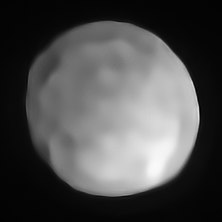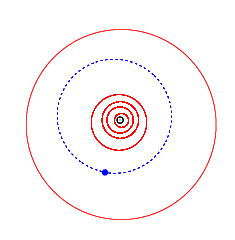  Animated orbit o Hygiea relative tae the orbits o the terrestrial planets an Jupiter. | |
| Discovery | |
|---|---|
| Discovered bi | A. de Gasparis |
| Discovery date | Aprile 12, 1849 |
| Designations | |
| Pronunciation | /haɪˈdʒiːə/ hy-JEE-ə |
Named after | Hygieia |
Alternative names | none |
Minor planet category | Main belt (Hygiea family) |
| Adjectives | Hygiean |
| Orbital chairactereestics[1] | |
| Epoch November 30, 2008 (JD 2454800.5) | |
| Aphelion | 3.507 AU (524.63 Gm) (Q) |
| Perihelion | 2.770 AU (414.38 Gm) (q) |
| 3.139 AU (469.58 Gm) | |
| Eccentricity | 0.117 |
Orbital period | 5.56 yr (2031.01 d) |
Average orbital speed | 16.76 km/s |
Mean anomaly | 197.96° (M) |
| Inclination | 3.842° |
Longitude o ascendin node | 283.45° |
Argument o perihelion | 313.19° |
| Proper orbital elements[2] | |
Proper semi-major axis | 3.1417827 AU |
Proper eccentricity | 0.1356315 |
Proper inclination | 5.1039060° |
Proper mean motion | 64.621768 deg / yr |
Proper orbital period | 5.57088 yr (2034.763 d) |
Precession o perihelion | 128.543611 arcsec / yr |
Precession of the ascending node | −96.902395 arcsec / yr |
| Pheesical chairacteristics | |
| Dimensions | 530×407×370 ±7 km[3] 431 km (mean) |
Surface area | 837,080.744 km2 (323,198.682 sq mi) |
| Mass | (8.67 ±0.15)×1019 kg[3] |
Mean density | 2.08 ± 0.10 g/cm³[3] |
Surface gravity | 0.091 m/s² |
Escape velocity | 0.21 km/s |
| 27.623 h (1.15 d)[1] | |
| Albedo | 0.0717 (geometric)[1] |
| Temperatur | ≈164 K max: 247 K (−26°C) [4] |
Spectral teep | C-type asteroid[1] |
Apparent magnitude | 9.0[5] to 11.97 |
| 5.43[1] | |
Angular diameter | 0.321″ tae 0.133″ |
10 Hygiea is the fowert lairgest asteroid in the Solar Seestem bi volume an mass, an it is locatit in the asteroid belt.
References
[eedit | eedit soorce]- ↑ a b c d e "JPL Small-Body Database Browser: 10 Hygiea". Retrieved 7 September 2008.
- ↑ "AstDyS-2 Hygiea Synthetic Proper Orbital Elements". Department of Mathematics, University of Pisa, Italy. Retrieved 1 October 2011.
- ↑ a b c Jim Baer (2010). "Recent Asteroid Mass Determinations". Personal Website. Archived frae the original on 21 October 2013. Retrieved 2 September 2011.
- ↑ L.F. Lim; McConnochie, T; Belliii, J; Hayward, T (2005). "Thermal infrared (8–13 µm) spectra of 29 asteroids: the Cornell Mid-Infrared Asteroid Spectroscopy (MIDAS) Survey". Icarus. 173 (2): 385. Bibcode:2005Icar..173..385L. doi:10.1016/j.icarus.2004.08.005.
- ↑ "AstDys (10) Hygiea Ephemerides". Department of Mathematics, University of Pisa, Italy. Retrieved 26 Juin 2010.
| Wikimedia Commons haes media relatit tae 10 Hygiea. |